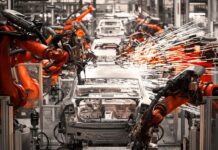
The Australian manufacturing sector has racked up its eighth consecutive month of recovery in May following the severe disruptions of COVID-19 in Q2 of 2020.
According to Ai Group’s latest report, the Australian Performance of Manufacturing Index (Australian PMI) posted a reading of 61.8 in May, which represents the index’s highest monthly result since March 2018 and the fourth highest since the Australian PMI commenced in 1992.
The report has found that all six manufacturing sectors in the Australian PMI® expanded in May and at a faster pace than in April.
“The strongest results were in the sectors that directly supply the construction sector, including building materials (up 3.8 points to 66.4), machinery & equipment (up 0.2 points to 64.7) and chemicals (up 2.1 points to 65.7),” reads the report.
Six of the seven activity indices in the Australian PMI also expanded in May, with production (up 0.9 points to 64.5), employment (up 3.3 points to 61.3) and new orders (up 1.5 points to 64.9) accelerating into very strong expansion. Only the exports index dropped into contraction (down 9.9 points to 48.9).
According to the report, the input prices index rose further in May (up 8.0 points to 82.1) due to high global commodity prices for metals, oil and other key inputs, as did manufacturers’ selling prices (up 5.4 points to 58.3), suggesting that more manufacturers are passing on some of these higher input costs to their customers.
The average wages index also rose again in May (up 1.1 points to 62.9), while the capacity utilisation index maintained April’s record high (unchanged at 85.1%).
Ai Group Chief Executive Innes Willox said the rapid pace of expansion in May was fuelled by strong demand from the construction sector, a pick-up in business investment and healthy demand from households.
“Each of the six diverse manufacturing groups expanded at a more rapid rate in the month led by the machinery & equipment; building products; and chemicals sectors,” Mr Willox noted.
“Manufacturing production and employment accelerated and, while the pace of expansion eased from April’s record high, sales also continued to rise.
“Manufacturers experienced further pressure on input costs and with wages also rising more rapidly, they are seeking to recover some of these extra costs from customers.”
He said that with capacity utilisation running at high levels and new orders continuing to grow, manufacturers are finding it increasingly difficult to fill positions.
“While the new Victorian lockdown will dampen enthusiasm somewhat, these conditions are likely to be setting the stage for a lift in investment by manufacturers,” Mr Willox concluded.




















